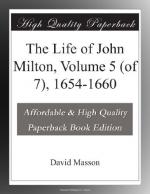[Footnote 1: Commons Journals of date.]
Before night Monk and his officers had drafted a Letter to all the regiments and garrisons of England, Scotland, and Ireland, explaining to them that, by the grace of God and good London management, they had passed through another revolution. The Letter began “Dear Brethren and Fellow-Soldiers,” and bore Monk’s signature, followed by those of Colonels Ralph Knight, John Clobery, Thomas Read, John Hubblethorn, Leonard Lydcott, Thomas Sanders, William Eyre, John Streater, Richard Mosse, William Parley, Arthur Evelyn, and sixteen inferior officers. It was vague, but intimated that the Government was still to be that of a Commonwealth, and that all disturbances of the peace “in favour of Charles Stuart or any other pretended authority” were to be put down. More explicit had been Monk’s speech at Whitehall that morning to the secluded members on their way to the House, published copies of which were also distributed by Monk’s authority. He had assured the secluded members, “and that in God’s presence,” that he had nothing before his eyes “but God’s glory and the settlement of these nations upon Commonwealth foundations”; and he had pointed out the interest of the Londoners especially in the preservation of a Commonwealth, “that Government only being capable to make them, through the Lord’s blessing, the metropolis and bank of trade for all Christendom.” On the Church question he had been very precise. “As to a Government in the Church,” he had said, “the want whereof hath been no small cause of these nations’ distractions, it is most manifest that, if it be monarchical in the State, the Church must follow and Prelacy must be brought in—which these nations, I know, cannot bear, and against which they have so solemnly sworn; and indeed moderate, not rigid, Presbyterian Government, with a sufficient liberty for consciences truly tender, appears at present to be the most indifferent and acceptable way to the Church’s settlement.” It is not uninteresting to know that Monk’s chief ecclesiastical adviser at this moment, and probably the person who had formulated for him the description of the kind of Church that would be most desirable, was Mr. James Sharp, from Crail in Scotland. He had followed Monk to London with a commission from the leaders of the Scottish Resolutioner clergy; and from his arrival there he had been, Baillie informs us, “the most wise, faithful, and happy counsellor” Monk had, keeping him from all wrong steps by his extraordinary Banffshire sagacity.[1]
[Footnote 1: Phillips, 688-689; Parl. Hist. III, 1579-1581 (Monk’s Speech and Declaration); Baillie, III. 440-441. How uncertain it was yet whether Monk would ever desert the Commonwealth, and how anxious the Royalists were on the subject, appears from a letter of Mordaunt to Charles, dated Feb. 17, 1659-60, or four days before the Restoration of the Secluded Members (Clar. State Papers, III. 683). Speaking of Monk, Mordaunt writes thus:—“The




